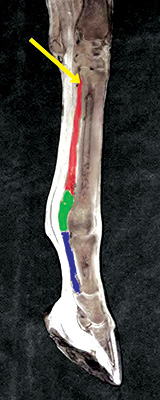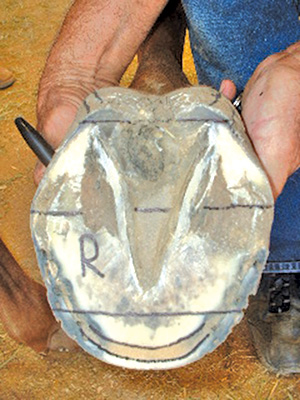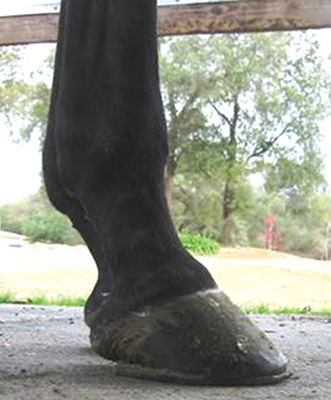It’s time for all of us who shoe horses to take the time to ask ourselves an important question about how we do our job.
I shod horses for 41 years. The last 20 were spent as the resident farrier at Loomis Basin Equine Medical Center in Northern California. After retiring in 2004, I started a consulting practice working with veterinarians, owners and farriers to assist in treating lameness issues in horses.
The case that I am presenting is not unusual nor rare. That’s what prompted me to write about it. The issues that caused the injury to this horse very easily could have been prevented with proper shoeing.
I’m not talking about a degree or two of misalignment of the hoof/pastern axis, or a hoof that went 4 or 5 days past 6 weeks. I’m not talking about a shoe that was fit a little too tight.
I’m talking about a 1,400-pound American warmblood, with a natural pastern angle of 56 degrees that was trimmed to 50 degrees. I’m talking about a horse that, when trimmed to its proper angle, wears a No. 5 shoe, but was shod instead in a No. 3 shoe.
I decided to write this article because I want everyone who reads it to understand the ramifications of this shoeing.
The Case

Figure 1. Location of the tear in the right front suspensory ligament.
The owner bought this gelding in January of 2011. She put the horse in training and started taking dressage lessons with him. The owner is an experienced horsewoman and noticed that the toes on the horse were getting long. She talked to the trainer about it and the trainer said she would speak to the farrier in regard to the long toes and broken-back hoof-pastern angles.
After the next shoeing, the owner again expressed her concerns about the long toes and low hoof angles. The trainer again said she would speak to the farrier.
In August the gelding went lame and was examined by a veterinarian.
The Veterinarian’s Diagnosis
This case being described is an 8-year-old warmblood gelding used for dressage. On Aug. 23, 2011, he tore his right front suspensory ligament 4 cm distal from the origin. The tear was moderate, extending approximately 5 cm.
The gelding was taken out of training and stall confined. He was treated with intralesional PRP (platelet-rich plasma) and rehabilitated. Rehabilitation consisted of walking under saddle one to two times a day, increasing by 5-minute increments. At 35 minutes, trotting was added. At 35 minutes of trotting, the canter was added.
Recheck ultrasounds were performed prior to trotting and cantering and whenever there was a concern. Rehab took 9 months.
“The suspensory ligament (Figure 1) at its origin is a mix of ligament and muscle fibers. It is situated between the splint bones and is attached to the back of the cannon bone.
It is an important part of the suspensory apparatus which prevents hyperextension of the fetlock, pastern and coffin joint.
Multiple Consequences

Figure 2. This foot is badly out of balance. Note how stretched the white line is.
I think it’s important to understand what the consequences are to this owner and others when something like this happens.
First off, the medical cost is very high. Veterinary examinations and ultrasounds are just the beginning. My consultation fees and therapeutic shoeing put the cost to the owner over $4,000. The trainer has also suffered a loss of income.
The rehabilitation program averaged 1 hour a day for 9 months of the owner’s time and the emotional factor is huge.
The owner paid a lot of money for this horse and planned to compete on it. The horse is further behind than it was a year ago because of the loss of training and muscle strength due to the injury. The owner is now concerned with the future. Is the site of this tear always going to be a weak spot? Will this horse be able to meet its full potential in dressage?
It’s sad to think that it has taken her longer to rehabilitate this horse’s injury than she has owned it in a sound condition.
How do we, as members of this profession, get farriers to understand the severe consequences of improper shoeing? As I noted, I have been in this profession for 49 years, 28 of those years working with just this kind of situation. Often, when a farrier loses a client, the client does not want to get into a verbal confrontation. So they don’t tell the farrier why they decided to change farriers. The farrier never calls to see why the owner dropped them. Communication is vital, and too often we aren’t good at it.
Basic Mistakes Hurt

Figure 3. See where the heels of this shoe end. The horse simply needs to be in a bigger shoe. The dorsal hoof wall is also not at the same angle as the pastern.
How do we get all farriers to understand that if you have more toe in front of the widest part of the foot than you have from the widest part of the foot back to the widest part of the frog, your foot is not balanced? Look at Figure 2, and note how stretched the white line is at the toe.
Your foot is also not balanced if the dorsal hoof wall is not at the same angle as the pastern. Look at Figure 3 and see where the heel of the shoe ends.
Why is this so hard to understand? Why is it so hard for some farriers to carry just one set of No. 4 and No. 5 shoes in their truck, just in case they happen to get a horse that needs that size? Surely this makes more sense than shoeing a horse in a shoe that’s the wrong size.
For Whose Good?
Is this a trainer issue as well? Do we let trainers dictate how we should do our job?
We always say we work for the horse, that the horse is our true client. Are we losing sight of that?
When we shoe a horse that does not have the perfect action that judges are looking for, is it correct to change the angles to make the horse move a certain way? If it will eventually cause lameness, I say no.
Using a special shoe for traction for events like jumping, or using sliding plates to help a horse slide further is fine. But to change a horse’s angles from its natural conformation, whether intentionally or non-intentionally, is disastrous. I know. That’s all I work with anymore. I see it regularly.
I hope that this case will make each and every one of us who shoe horses look at our finished jobs and ask ourselves a very important question.
Is this the absolute best that I can do for this horse?







Post a comment
Report Abusive Comment